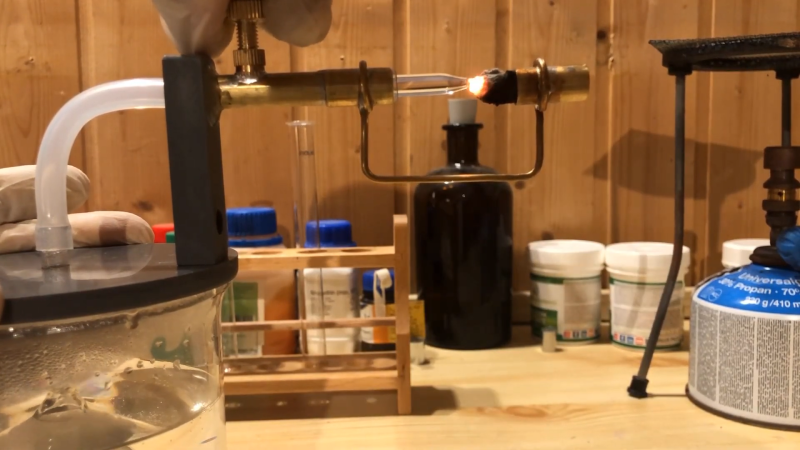With our mass-produced butane lighters and matches made in the billions, fire is never more than a flick of the finger away these days. But starting a fire 200 years ago? That’s a different story.
One method we’d never heard of was Döbereiner’s lamp, an 1823 invention by German chemist Johann Wolfgang Döbereiner. At first glance, the device seems a little sketchy, what with a tank of sulfuric acid and a piece of zinc to create a stream of hydrogen gas ignited by a platinum catalyst. But as [Marb’s Lab] shows with the recreation in the video below, while it’s not exactly as pocket-friendly as a Zippo, the device actually has some inherent safety features.
[Marb]’s version is built mainly from laboratory glassware, with a beaker of dilute sulfuric acid — “Add acid to water, like you ought-er!” — bathing a chunk of zinc on a fixed support. An inverted glass funnel acts as a gas collector, which feeds the hydrogen gas to a nozzle through a pinch valve. The hydrogen gas never mixes with oxygen — that would be bad — and the production of gas stops once the gas displaces the sulfuric acid below the level of the zinc pellet. It’s a clever self-limiting feature that probably contributed to the commercial success of the invention back in the day.
To produce a flame, Döbereiner originally used a platinum sponge, which catalyzed the reaction between hydrogen and oxygen in the air; the heat produced by the reaction was enough to ignite the mixture and produce an open flame. [Marb] couldn’t come up with enough of the precious metal, so instead harvested the catalyst from a lighter fluid-fueled hand warmer. The catalyst wasn’t quite enough to generate an open flame, but it glowed pretty brightly, and would be more than enough to start a fire.
Hats off to [Marb] for the great lesson is chemical ingenuity and history. We’ve seen similar old-school catalytic lighters before, too.
Thanks to [M. Bindhammer] for the tip.

















Enlightening!
Reminds me of the “Galvanick Lucifer” from Neal Stephenson’s Cryptonomicon; not a real device but a neat idea all the same.
If the hydrogen burns without oxygen this is revolutionary!
The truth is, it is obvious that what is meant is that there should be only hydrogen and no hydrogen/air mixture in the funnel.
Show you just addictive nicotine must be if anyone would go through all this trouble for a light.
Back then opium or hashish just might have been in a wealthy gentleman’s smoking room along with the new tech and other wonders of the age.
No smell like a Lucifer (1836 the first match) and once set it’s regulating it’s output.
Turn knob convenience.
No burning stick to put out whilst enjoying your pipe or getting candle wax on it.
I wouldn’t want to leave the one shown in the video going for a long time. Why? Because of how the zinc support is made. A bit of stretch was done to neck it down to the size of hole drilled in the zinc piece. But there’s a length of straight support beneath the zinc.
Think about what would happen once the acid decomposes enough of the zinc to enlarge the center hole. *plop* Down it goes into the acid where the hydrogen can then go outside the funnel.
Doesn’t matter that it’s a demonstration device not meant for long term use. Repeated short term demonstrations would eventually erode the hole too much. Something acid proof should be added to the support so the zinc can’t fall down until it would be all gone.
If this was a commercially produced science class product, it would eventually be recalled after causing a few explosions.
Simply remove the sulfuric acid after the demonstration and pour it back into a prepared bottle. No chemistry teacher allows an experiment to continue unobserved.
I once saw a device like that in a museum. Ever since I really wanted to have one ;-)